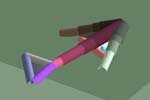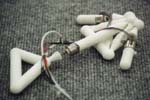
The Golem Project
Hod Lipson and Jordan B. Pollack


|
|

|
While both the machines and task we describe in this work are fairly simple from the perspective of what human teams of engineers can produce, and what biological evolution has produced, we have demonstrated for the first time a robotic bootstrap, where automatically designed electromechanical systems have been manufactured robotically. We have carefully minimized human intervention both in the design and in the fabrication stages. Besides snapping in the motors, the only human work was in informing the simulation about the universe that could be manufactured.
Without reference to specific organic chemistry, life is an autonomous
design process that is in control of a complex set of chemical
factories allowing the generation and testing of physical entities
which exploit the properties of the medium of their own construction.
Using a different medium, namely off-the-shelf rapid manufacturing,
and evolutionary design in simulation, we have made progress towards
replicating this autonomy of design and manufacture. This is the
first time any artificial evolution system has been connected
to an automatic physical construction system. All together, our
evolutionary design system, solidification process, and rapid
prototyping machine form a primitive "replicating" robot.
While there are many, many further steps before this technology
is dangerous , we believe that if indeed artificial systems are
to ultimately interact and integrate with reality, they cannot
remain virtual; it is crucial that they cross the simulation-reality
gap to learn, evolve and affect the physical world directly .
Eventually, the evolutionary process must accept feedback from
the live performance of its products.
Future work is primarily needed in understanding how more
complex modular structures might self-organize, and how these
complex structures may transfer into reality under control of
the evolutionary process. Technological advances in MEMS, nano-fabrication
and multi-material rapid prototyping that can embed circuits and
actuators in bulk structure, higher fidelity physical simulation,
and increased understanding of evolutionary computational processes
may pave the way for what Moravec has termed "Escape Velocity"
.
|
Copyright (c) 2000 Lipson & Pollack |
lipson@cs.brandeis.edu |
Updated |